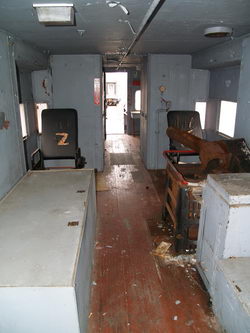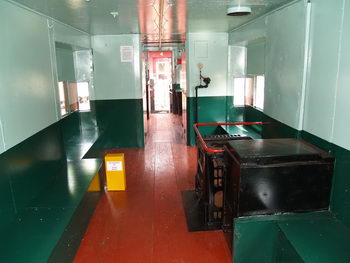
Erie Lackawanna Railway Bay-Window Caboose No. C372
This steel bay-Window caboose was constructed by the International Car Co. of Kenton, Ohio for the Erie Lackawanna Railway (EL) in September 1970. No. C372 is one of a batch of ten that would be the last cabooses built for the the EL. Virtually identical to earlier sisters C351-C370, the newer C371-C380 series lacked roofwalks, conforming to new federal railroad regulations. These modern cabooses wore the current (at that time) “Spartan Red” paint scheme.


As the years went on, the EL decided to brighten up its dusty red cabooses in a new scheme, thanks to the suggestion of a shipper. The new scheme was essentially a reverse image of its diesel paint scheme: Maroon body, gray stripe, and yellow accent striping. The new “gray/maroon/yellow” (or “GMY”) scheme became the standard, and the railroad hurried to repaint as many cabooses as possible before the railroad’s inclusion into Conrail in 1976. The C372 was one of the fortunate group that received this paint.
Upon the startup of Conrail in 1976, many of the EL’s bay-window cabooses were conveyed to the Delaware & Hudson Railway (D&H). In the 1990s, the D&H overhauled and sold several of these cabooses to NJ TRANSIT (NJT), where they were to be used in NJT work train service. NJT donated this car (ex-NJT No. 907) to the Whippany Railway Museum in 2008.

What is a ‘Bay-Window’ Caboose?
With the shift from wooden to steel caboose construction was the introduction of a new caboose design that replaced the traditional roof-mounted “cupola” with “bay-windows” attached to the sides of the caboose. As freight cars grew taller, the effectiveness of cupolas as practical observation points was diminished. This was especially true on lines that suffered from low clearances and were incapable of making cupolas high enough to see over the top of the tallest freight cars. Cabooses were prone to rough handling, and many a trainman was knocked out of his perch in the cupola and injured when he fell.


The Baltimore & Ohio was a true bay-window caboose pioneer when it experimented with the bay-window concept as early as 1929. The Milwaukee Road, was another early proponent of the bay-window caboose, adopting the design in 1939. The New York Central was one of the largest users of steel bay-window cabooses, acquiring hundreds of them after World War II to replace older wooden designs.


By the mid-1950’s, many railroads were switching to the bay-window design, and far fewer cupola cabooses were being built. In the West, Southern Pacific and Western Pacific were among the roads that favored the bay-window designs, while Santa Fe and Northern Pacific continued with more traditional designs. In Canada, Canadian National and Canadian Pacific stuck with the cupola caboose right until the end of regular caboose operations in North America in the late 1980’s.





With its restoration complete, the EL C372 was ready to take on its first happy passengers during the Museum’s Caboose Train
